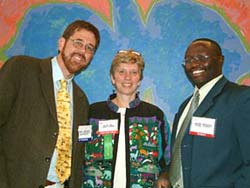Small resource changes might help Kenyans escape poverty trap

Alice Pell and her Nairobi collaborators, Louis Verchot of the International Centre for Research in Agroforestry (left) and David Mbugua, Cornell Ph.D. Õ03, are studying how small changes in natural resources could have profound effects on the lives of poor villagers. Cornell News Service phto by David BrandCopyright © Cornell University
Madzuu is a village in Kenya’s western highlands and Lake Victoria basin where the rainfall is abundant, and there is some access to urban markets. And yet about 61 percent of the village population earned less than 50 cents a day in real terms in both 1989 and 2002. Many people there are trapped in chronic poverty from which escape is difficult.
Alice Pell, professor of animal science at Cornell University, Ithaca, N.Y., is the principal investigator on a five-year, multidisciplinary research effort to study how small changes in natural resources could have profound effects on people’s lives. In Madzuu’s case, restoring the land’s natural productivity could alter the economic situation of the farmers.
Pell reported on the research team’s first year of work today (Feb. 14) at the annual meeting of the American Association for the Advancement of Science in Seattle. Her talk, “The Interplay Between Small Farms and Fragile Tropical Ecosystems in Kenya,” was part of the “Frontiers in Biocomplexity Science” portion of the “Connections in the Real World” symposium.
In addition to working in the Lake Victoria basin, the researchers are studying a second village, Embu, on the shoulder of Mount Kenya. Both villages have high agricultural potential despite dense populations and small farm size.
Yet there is a big difference between the two villages. In Madzuu, soil degradation is extensive, and more than half the farmers earn less than $205 per capita annually, the Kenyan poverty line. The reason? Madzuu farmers use few soil inputs, such as fertilizers, resulting in loss of rich soil, accelerating the downward, economic spiral, said Pell. “Limited movement out of poverty between 1989 and 2002 in Madzuu suggests the existence of poverty traps,” she said. The soils in Madzuu farmland contain just 16.3 grams per kilogram of soil organic carbon and only 1.6 grams per kilogram of nitrogen. By comparison, preliminary research shows that Embu’s farmers commonly use more fertilizers and other inputs to maintain soil quality. Consequently, Embu cropland contains roughly twice as much soil organic carbon (35.6 grams per kilogram) and nitrogen (3.4 grams per kilogram).
The research team also includes Susan Riha, Cornell’s C. L. Pack Research Professor of Forest Soils; Johannes Lehmann, Cornell assistant professor of crop and soils science; and Christopher Barrett, Cornell assistant professor of applied economics and management. Working with the team are scientists from the Kenyan Agricultural Research Institute and the World Agroforestry Centre in Nairobi. The project is funded by the Coupled Natural and Human Systems program of the National Science Foundation’s Biocomplexity initiative.
Media Contact
More Information:
http://www.news.cornell.edu/releases/Feb04/AAAS.Pell.bpf.htmlAll latest news from the category: Interdisciplinary Research
News and developments from the field of interdisciplinary research.
Among other topics, you can find stimulating reports and articles related to microsystems, emotions research, futures research and stratospheric research.
Newest articles

An Endless Loop: How Some Bacteria Evolve Along With the Seasons
The longest natural metagenome time series ever collected, with microbes, reveals a startling evolutionary pattern on repeat. A Microbial “Groundhog Year” in Lake Mendota Like Bill Murray in the movie…

Witness Groundbreaking Research on Achilles Tendon Recovery
Achilles tendon injuries are common but challenging to monitor during recovery due to the limitations of current imaging techniques. Researchers, led by Associate Professor Zeng Nan from the International Graduate…

Why Prevention Is Better Than Cure—A Novel Approach to Infectious Disease Outbreaks
Researchers have come up with a new way to identify more infectious variants of viruses or bacteria that start spreading in humans – including those causing flu, COVID, whooping cough…



